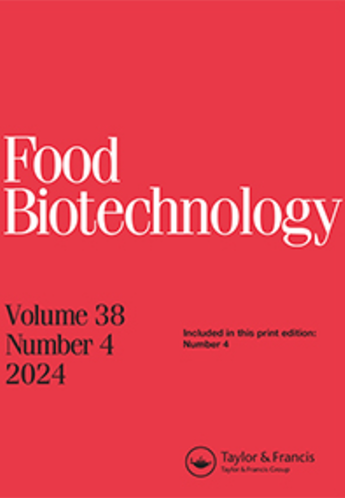Technological and beneficial features of lactic acid bacteria isolated from Boza A cereal-based fermented beverage
IF 1.6
4区 农林科学
Q4 BIOTECHNOLOGY & APPLIED MICROBIOLOGY
引用次数: 3
Abstract
ABSTRACT Limosilactobacillus fermentum M3F, Levilactobacillus brevis M18F, Leuconostoc citreum M26F, Lactobacillus pentosus M7F, Lactiplantibacillus plantarum M15F, Leuconostoc lactis M31F, Lactococcus lactis M2F, and Lacticaseibacillus paracasei M32F were isolated from Boza samples produced in Turkey. The technological and beneficial features of the bacterial isolates were then evaluated. L. pentosus showed antibacterial activity against all pathogenic bacteria, which included Staphylococcus aureus ATCC 2393, Escherichia coli ATCC 25922, Escherichia coli O157:H7 ATCC 33150, Salmonella Enteritidis ATCC 13076, Vibrio parahaemolyticus ATCC 17802 and Listeria monocytogenes ATCC 7644. L. plantarum was also effective against all pathogens except L. monocytogenes. The resistance of the isolates to 0.3% bile salt was between 102−110% of the viability rate after 4h. The highest hydrophobicity was found in L. plantarum (90.99%), L. brevis (64.23%), L. fermentum (60.57%), and L. pentosus (50.59%). In addition, L. plantarum, L. pentosus, L. fermentum, and L. brevis were viable in a pH range of 2–9.6 and showed an ability to grow in the presence of high NaCl concentrations (10%).博扎A谷类发酵饮料中乳酸菌的分离及其有益特性
摘要从土耳其博扎生产的样品中分离到发酵乳杆菌M3F、短乳杆菌M18F、柠檬明串珠菌M26F、戊糖乳杆菌M7F、植物乳杆菌M15F、乳酸明串珠菌M31F、乳酸乳球菌M2F和副干酪乳杆菌M32F。然后对分离菌株的技术和有益特性进行了评价。戊糖乳杆菌对所有致病菌均表现出抗菌活性,包括金黄色葡萄球菌ATCC 2393、大肠杆菌ATCC 25922、大肠杆菌O157:H7 ATCC 33150、肠炎沙门氏菌ATCC 13076、副溶血性弧菌ATCC 17802和单核细胞增生性李斯特菌ATCC 7644。植物乳杆菌对除单核细胞增多性乳杆菌外的所有病原体也有效。4小时后,分离株对0.3%胆汁盐的抗性在102−110%之间。植物乳杆菌(90.99%)、短乳杆菌(64.23%)、发酵乳杆菌(60.57%)和戊糖乳杆菌(50.59%。
本文章由计算机程序翻译,如有差异,请以英文原文为准。
求助全文
约1分钟内获得全文
求助全文
来源期刊

Food Biotechnology
工程技术-生物工程与应用微生物
CiteScore
3.80
自引率
0.00%
发文量
15
审稿时长
>12 weeks
期刊介绍:
Food Biotechnology is an international, peer-reviewed journal that is focused on current and emerging developments and applications of modern genetics, enzymatic, metabolic and systems-based biochemical processes in food and food-related biological systems. The goal is to help produce and improve foods, food ingredients, and functional foods at the processing stage and beyond agricultural production.
Other areas of strong interest are microbial and fermentation-based metabolic processing to improve foods, food microbiomes for health, metabolic basis for food ingredients with health benefits, molecular and metabolic approaches to functional foods, and biochemical processes for food waste remediation. In addition, articles addressing the topics of modern molecular, metabolic and biochemical approaches to improving food safety and quality are also published.
Researchers in agriculture, food science and nutrition, including food and biotechnology consultants around the world will benefit from the research published in Food Biotechnology. The published research and reviews can be utilized to further educational and research programs and may also be applied to food quality and value added processing challenges, which are continuously evolving and expanding based upon the peer reviewed research conducted and published in the journal.
 求助内容:
求助内容: 应助结果提醒方式:
应助结果提醒方式:


